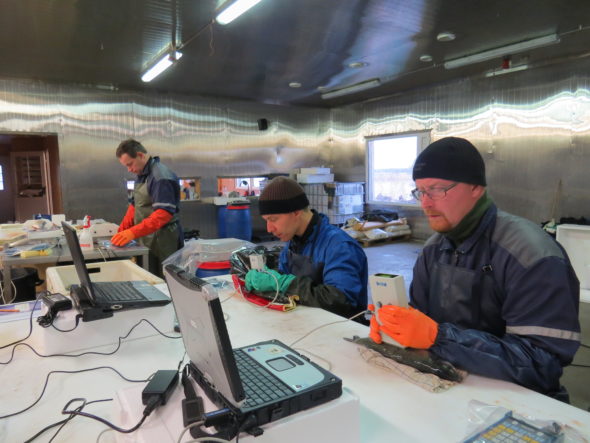In aquaculture, as in other sectors of animal farming, improving the efficiency through genetics and nutrition has been very effective to improve sustainability. These two focus areas of AquaIMPACT lead to the recording of many measurements on many fish, at many timepoints and locations. Recording of something simple such as body weight is not trivial when animals are swimming and recording is frequent, let alone something more sophisticated, such as product quality, or animal health and well-being. Analysis of these increasingly large amounts of data also requires methodology that yields precise and specific results for decision-making by farmers, breeders and nutritionists.
Recording
Digital recording is taking enormous leaps in agriculture. Novel technologies are imaging and the use of sensors which can, for instance, be used to track behavior of individuals or groups and also to record smart phenotypes. Some reports are even seen on identification of fish from image recognition. Sensors can be used to measure physiological traits on fish, and both sensors and imaging create very large datasets in a short time, avoiding labor intensive recording. In AquaIMPACT, we are developing applications of imaging technology combined with robotics for high-throughput measuring of live fish, and imaging combined with spectrometry to measure omega-3 content on fish fillets.

Phenotypes
Standard color pictures and 3-dimensional images are used in AquaIMPACT to predict accurate weights and to measure standard traits like length and thickness. The next challenges are to predict more difficult to obtain traits, like slaughter yield and fillet weights using machine learning and other artificial intelligence (AI) technologies. Performance data that includes details like behavior and environmental conditions (such as pathogen presence or water conditions) gives valuable information that can be used to model the performance of growing fish.
Smart software
Having frequent performance measures on fish, and combining this with detailed information on the ingredients and feeding rates, allows the modelling of fish growth. In AquaIMPACT, models are developed based on a combination of mechanistic process modelling with machine learning technology to predict fish performance based on feed composition, without the need to perform field testing with many different diets. The use of these models as a tool to pre-screen diets will lead to a reduction in costs of feeding trials, and an improvement in the cost/benefit ratio of field tests. In addition, models are being developed to allow selection of individual fish by combining image data obtained in real time with genetic information on those same fish that is stored in a breeding program database. These real-time selection models will allow a high throughput in the selection process, decreasing the handling of fish with the aim to improve the selection response.
Integration of genetics and nutrition
Combining the results from innovations in breeding programs and in nutritional inputs will inform better decision-making for fish breeders and fish farmers. In AquaIMPACT, practical tools are being developed to predict the nutritional requirements of genetically-superior fish, as well as their performance when fed different feed compositions. The genetic potential for fish growth and performance, together with knowledge on the effects of nutritional factors, in combination with the impacts of realized environmental conditions, will enable precision farming in aquaculture.
Text: John Bastiaansen & Jochen Hemming (WUR), Luis Conceição & Tome Silva (SPAROS)
